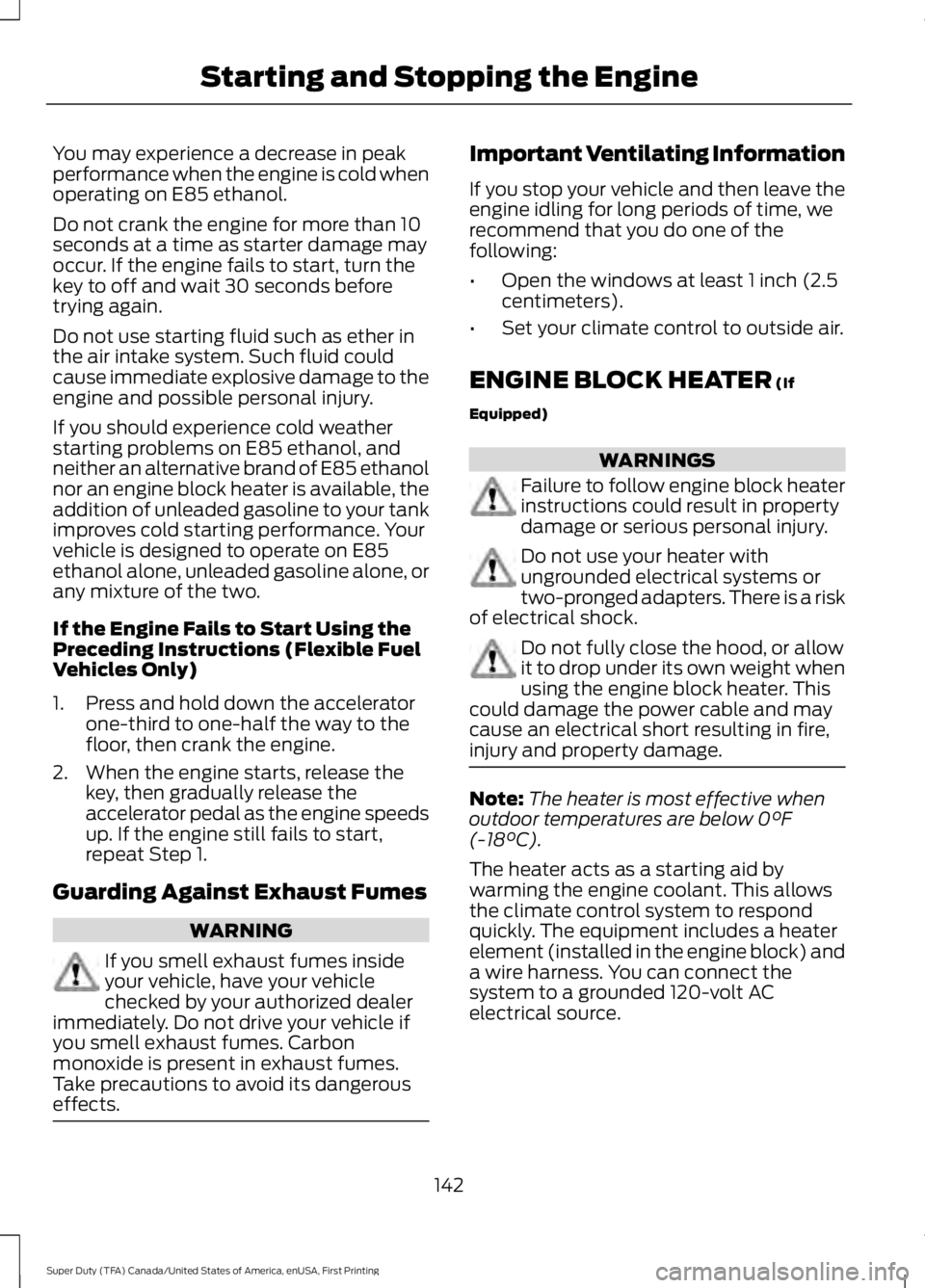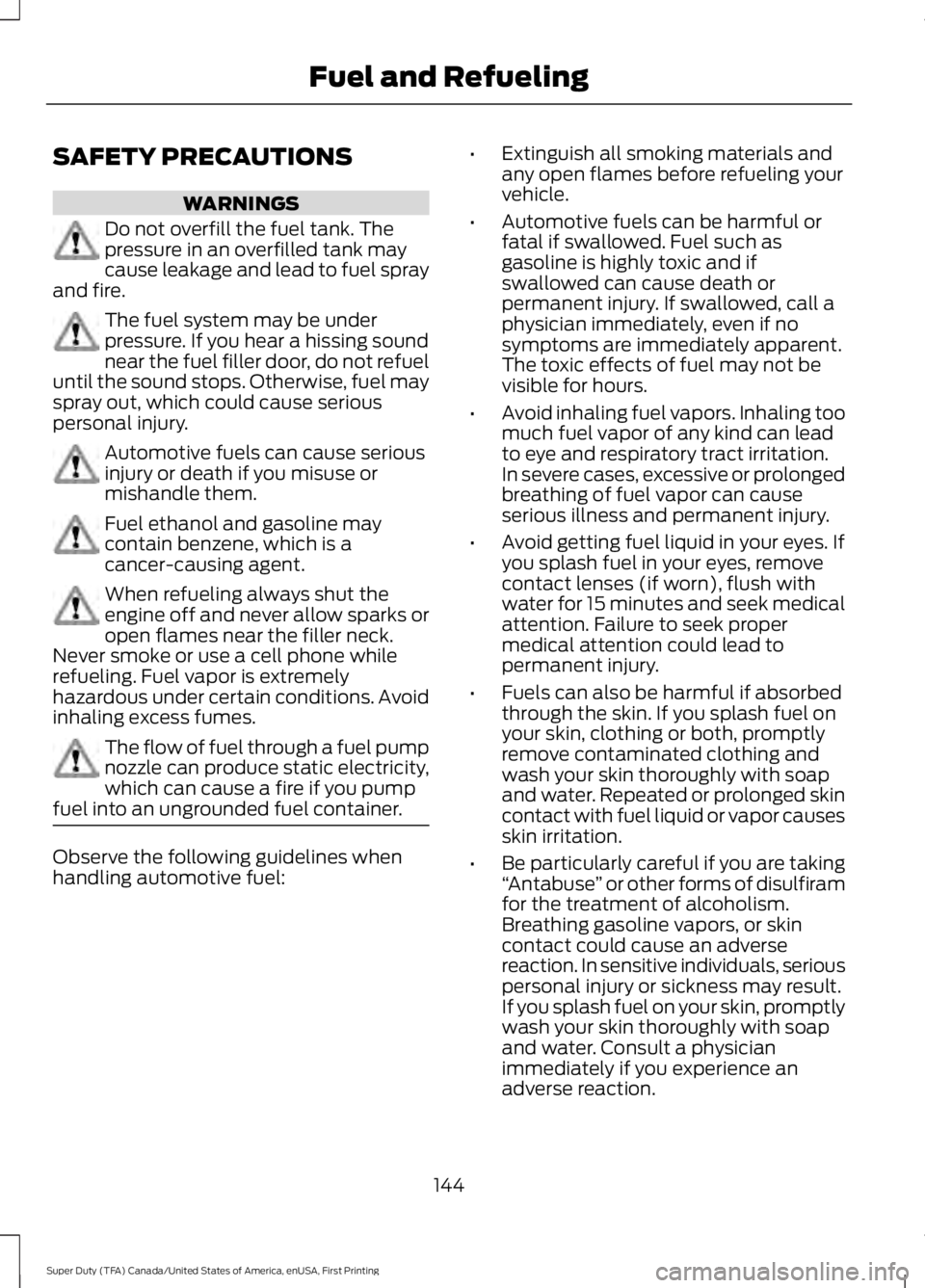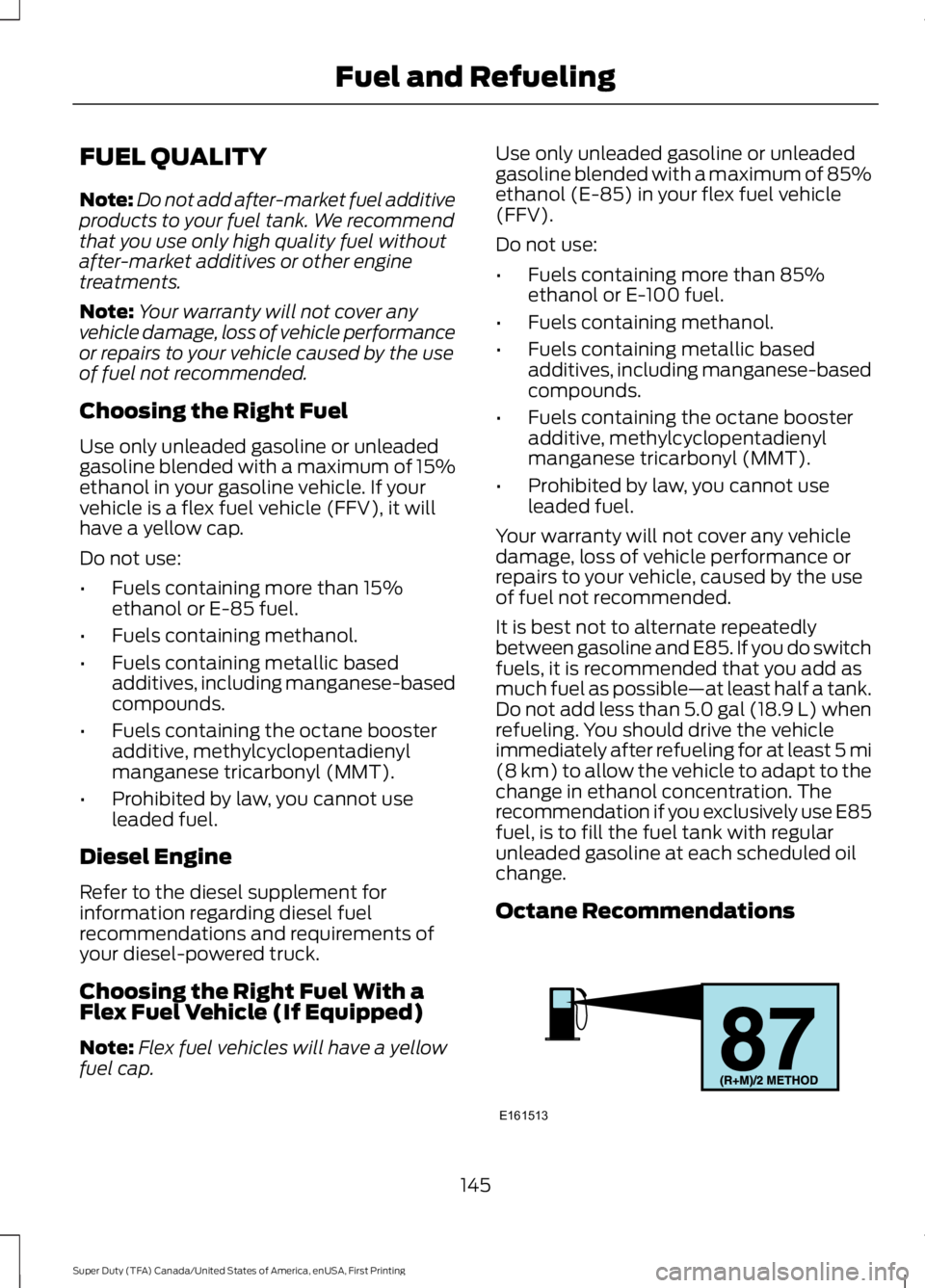2016 FORD F450 SUPER DUTY open gas tank
[x] Cancel search: open gas tankPage 145 of 507

You may experience a decrease in peakperformance when the engine is cold whenoperating on E85 ethanol.
Do not crank the engine for more than 10seconds at a time as starter damage mayoccur. If the engine fails to start, turn thekey to off and wait 30 seconds beforetrying again.
Do not use starting fluid such as ether inthe air intake system. Such fluid couldcause immediate explosive damage to theengine and possible personal injury.
If you should experience cold weatherstarting problems on E85 ethanol, andneither an alternative brand of E85 ethanolnor an engine block heater is available, theaddition of unleaded gasoline to your tankimproves cold starting performance. Yourvehicle is designed to operate on E85ethanol alone, unleaded gasoline alone, orany mixture of the two.
If the Engine Fails to Start Using thePreceding Instructions (Flexible FuelVehicles Only)
1. Press and hold down the acceleratorone-third to one-half the way to thefloor, then crank the engine.
2. When the engine starts, release thekey, then gradually release theaccelerator pedal as the engine speedsup. If the engine still fails to start,repeat Step 1.
Guarding Against Exhaust Fumes
WARNING
If you smell exhaust fumes insideyour vehicle, have your vehiclechecked by your authorized dealerimmediately. Do not drive your vehicle ifyou smell exhaust fumes. Carbonmonoxide is present in exhaust fumes.Take precautions to avoid its dangerouseffects.
Important Ventilating Information
If you stop your vehicle and then leave theengine idling for long periods of time, werecommend that you do one of thefollowing:
•Open the windows at least 1 inch (2.5centimeters).
•Set your climate control to outside air.
ENGINE BLOCK HEATER (If
Equipped)
WARNINGS
Failure to follow engine block heaterinstructions could result in propertydamage or serious personal injury.
Do not use your heater withungrounded electrical systems ortwo-pronged adapters. There is a riskof electrical shock.
Do not fully close the hood, or allowit to drop under its own weight whenusing the engine block heater. Thiscould damage the power cable and maycause an electrical short resulting in fire,injury and property damage.
Note:The heater is most effective whenoutdoor temperatures are below 0°F(-18°C).
The heater acts as a starting aid bywarming the engine coolant. This allowsthe climate control system to respondquickly. The equipment includes a heaterelement (installed in the engine block) anda wire harness. You can connect thesystem to a grounded 120-volt ACelectrical source.
142
Super Duty (TFA) Canada/United States of America, enUSA, First Printing
Starting and Stopping the Engine
Page 147 of 507

SAFETY PRECAUTIONS
WARNINGS
Do not overfill the fuel tank. Thepressure in an overfilled tank maycause leakage and lead to fuel sprayand fire.
The fuel system may be underpressure. If you hear a hissing soundnear the fuel filler door, do not refueluntil the sound stops. Otherwise, fuel mayspray out, which could cause seriouspersonal injury.
Automotive fuels can cause seriousinjury or death if you misuse ormishandle them.
Fuel ethanol and gasoline maycontain benzene, which is acancer-causing agent.
When refueling always shut theengine off and never allow sparks oropen flames near the filler neck.Never smoke or use a cell phone whilerefueling. Fuel vapor is extremelyhazardous under certain conditions. Avoidinhaling excess fumes.
The flow of fuel through a fuel pumpnozzle can produce static electricity,which can cause a fire if you pumpfuel into an ungrounded fuel container.
Observe the following guidelines whenhandling automotive fuel:
•Extinguish all smoking materials andany open flames before refueling yourvehicle.
•Automotive fuels can be harmful orfatal if swallowed. Fuel such asgasoline is highly toxic and ifswallowed can cause death orpermanent injury. If swallowed, call aphysician immediately, even if nosymptoms are immediately apparent.The toxic effects of fuel may not bevisible for hours.
•Avoid inhaling fuel vapors. Inhaling toomuch fuel vapor of any kind can leadto eye and respiratory tract irritation.In severe cases, excessive or prolongedbreathing of fuel vapor can causeserious illness and permanent injury.
•Avoid getting fuel liquid in your eyes. Ifyou splash fuel in your eyes, removecontact lenses (if worn), flush withwater for 15 minutes and seek medicalattention. Failure to seek propermedical attention could lead topermanent injury.
•Fuels can also be harmful if absorbedthrough the skin. If you splash fuel onyour skin, clothing or both, promptlyremove contaminated clothing andwash your skin thoroughly with soapand water. Repeated or prolonged skincontact with fuel liquid or vapor causesskin irritation.
•Be particularly careful if you are taking“Antabuse” or other forms of disulfiramfor the treatment of alcoholism.Breathing gasoline vapors, or skincontact could cause an adversereaction. In sensitive individuals, seriouspersonal injury or sickness may result.If you splash fuel on your skin, promptlywash your skin thoroughly with soapand water. Consult a physicianimmediately if you experience anadverse reaction.
144
Super Duty (TFA) Canada/United States of America, enUSA, First Printing
Fuel and Refueling
Page 148 of 507

FUEL QUALITY
Note:Do not add after-market fuel additiveproducts to your fuel tank. We recommendthat you use only high quality fuel withoutafter-market additives or other enginetreatments.
Note:Your warranty will not cover anyvehicle damage, loss of vehicle performanceor repairs to your vehicle caused by the useof fuel not recommended.
Choosing the Right Fuel
Use only unleaded gasoline or unleadedgasoline blended with a maximum of 15%ethanol in your gasoline vehicle. If yourvehicle is a flex fuel vehicle (FFV), it willhave a yellow cap.
Do not use:
•Fuels containing more than 15%ethanol or E-85 fuel.
•Fuels containing methanol.
•Fuels containing metallic basedadditives, including manganese-basedcompounds.
•Fuels containing the octane boosteradditive, methylcyclopentadienylmanganese tricarbonyl (MMT).
•Prohibited by law, you cannot useleaded fuel.
Diesel Engine
Refer to the diesel supplement forinformation regarding diesel fuelrecommendations and requirements ofyour diesel-powered truck.
Choosing the Right Fuel With aFlex Fuel Vehicle (If Equipped)
Note:Flex fuel vehicles will have a yellowfuel cap.
Use only unleaded gasoline or unleadedgasoline blended with a maximum of 85%ethanol (E-85) in your flex fuel vehicle(FFV).
Do not use:
•Fuels containing more than 85%ethanol or E-100 fuel.
•Fuels containing methanol.
•Fuels containing metallic basedadditives, including manganese-basedcompounds.
•Fuels containing the octane boosteradditive, methylcyclopentadienylmanganese tricarbonyl (MMT).
•Prohibited by law, you cannot useleaded fuel.
Your warranty will not cover any vehicledamage, loss of vehicle performance orrepairs to your vehicle, caused by the useof fuel not recommended.
It is best not to alternate repeatedlybetween gasoline and E85. If you do switchfuels, it is recommended that you add asmuch fuel as possible—at least half a tank.Do not add less than 5.0 gal (18.9 L) whenrefueling. You should drive the vehicleimmediately after refueling for at least 5 mi(8 km) to allow the vehicle to adapt to thechange in ethanol concentration. Therecommendation if you exclusively use E85fuel, is to fill the fuel tank with regularunleaded gasoline at each scheduled oilchange.
Octane Recommendations
145
Super Duty (TFA) Canada/United States of America, enUSA, First Printing
Fuel and RefuelingE161513